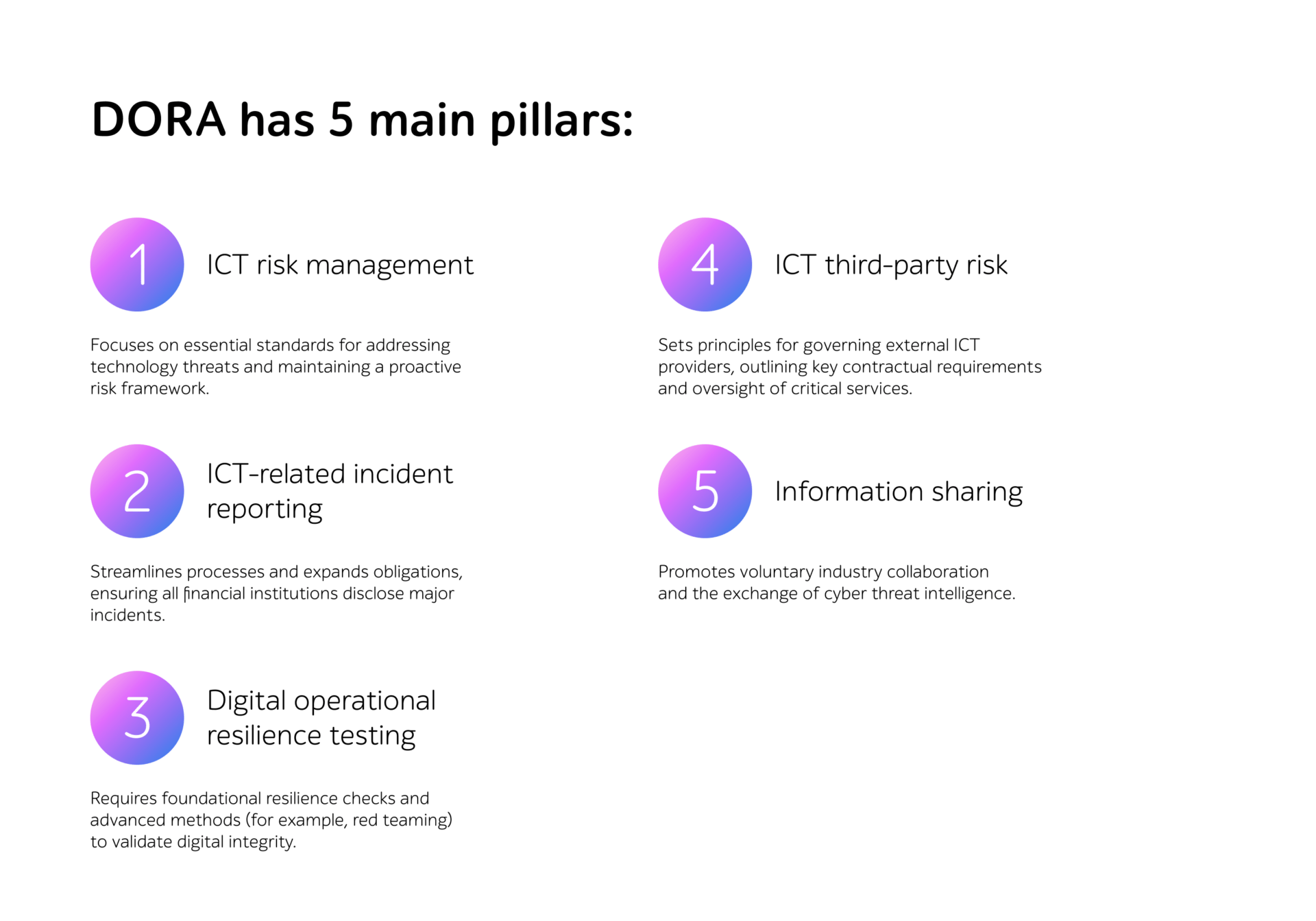
Fintech and DORA: the role of testing in ensuring digital sustainability
These days, the financial sector never sleeps, staying online and connected around the clock while facing a myriad of digital threats. Banks, FinTechs, asset managers, crypto exchanges, and insurance providers have all harnessed technology to improve how customers access and manage their money. But what happens when critical systems fail, or hackers find a weakness? That’s where the EU’s Digital Operational Resilience Act (DORA) comes into play.
DORA ensures that any financial entity operating in the European Union can withstand and recover from technology-related disruptions. While it touches on governance, third-party risk management, incident reporting, and more, a crucial aspect is the way organizations must rigorously test their systems. This is where QA can play a crucial role, helping companies make sure their digital operations are as resilient as possible.
In this article, we’ll review role of QA teams ensuring compliance with DORA’s stringent regulations.
DORA’s pillars and where testing fits
A brief look at the regulation
DORA harmonizes the rules around digital operational resilience across all EU member states rather than letting each country set its own guidelines for financial entities.
DORA has 5 main pillars:

- ICT risk management
Focuses on essential standards for addressing technology threats and maintaining a proactive risk framework.
- ICT-related incident reporting
Streamlines processes and expands obligations, ensuring all financial institutions disclose major incidents.
- Digital operational resilience testing
Requires foundational resilience checks and advanced methods (for example, red teaming) to validate digital integrity.
- ICT third-party risk
Sets principles for governing external ICT providers, outlining key contractual requirements and oversight of critical services.
- Information sharing
Promotes voluntary industry collaboration and the exchange of cyber threat intelligence.
The role of QA teams
A QA team typically checks that software does what it’s designed for, in accordance with requirements, with the aim to fit desired quality gates. By designing and documenting resilience mechanisms as system requirements, QA teams gain a strategic framework for testing these critical aspects. That includes proactively searching for vulnerabilities, verifying the strength of disaster recovery processes, and even simulating real-world attack scenarios. By conducting security testing and collaborating with security and DevOps colleagues, QA teams become a linchpin in demonstrating regulatory compliance to both management and external regulators.
QA and DORA
Testing as part of Secure Software Development Lifecycle (SSDLC)
Building security into software from the start is far more effective than scrambling to fix issues before launch. A Secure Software Development Lifecycle (SSDLC) approach ensures security is considered at every stage of development. From planning to release, early detection reduces risks and strengthens resilience against cyber threats. This approach emphasizes continuous security validation instead of one-time compliance checks.
QA’s role:
- Help define security priorities by working with security teams to identify key risks and ensure business-critical applications meet compliance and security expectations.
- Support security checks during development, making sure vulnerabilities are flagged and addressed early in the process.
- Ensure security is tested during integration, confirming that data exchanges, authentication systems, and external connections are secure.
- Oversee re-tests after fixes, ensuring that previously identified issues are resolved before moving forward.
SSDLC reinforces the ICT risk management pillar by embedding security into every stage of development and bolsters the digital operational resilience testing pillar through continuous system validation, thereby enhancing overall resilience.
Performance testing (ensuring service continuity)
DORA’s scope isn’t limited to cyber threats. A major system overload can also jeopardize financial stability. Think of a trading platform meltdown at peak market hours or a payment gateway crashing on Black Friday.
QA’s role:
- Simulate high-traffic scenarios by utilizing a user behaviour approach.
- Monitor system performance by tracking key metrics, including:
- Response time of major transactions
- Number of requests per second
- Number of transactions per second
- Early warning signs of resource exhaustion
- Provide data to management about how close the system might be to critical load or resource exhaustion.
Service continuity is an important aspect of the operational resilience testing pillar. Testing ensures you’re better prepared to handle sudden spikes and can meet the service availability thresholds demanded by regulators and customers alike.
Integration testing
DORA places strong emphasis on ensuring financial entities can maintain seamless operations across all interconnected systems. This includes third-party vendors, internal platforms, and cross-departmental data flows. Failures in internal integrations—not just external dependencies—can disrupt critical services, affecting compliance, customer trust, and financial stability.
QA’s role:
- Map out all integration points, e.g. customer onboarding to KYC (Know Your Customer) checks to payment gateways.
- Continuously test the data exchange and error-handling routines between your system and external APIs.
- Conduct fallback scenario testing. If a key third-party service is offline, does your system fail gracefully, queue transactions, or switch to a backup provider?
With integration testing organizations can prove they can sustain operations under disruptions, whether from internal failures or third-party issues. This approach supports the Digital operational resilience testing pillar by validating system integrity and maps to the ICT third-party risk pillar by ensuring that integrations on external providers remain robust.
Patch management and release testing
DORA obligates that financial institutions must actively manage their technology assets to maintain security, stability, and compliance with evolving regulations. Outdated systems create unnecessary risks, leaving organizations vulnerable to cyber threats, operational failures, and regulatory scrutiny. Regular updates are crucial, as they often resolve critical security flaws and enhance performance, yet improper implementation can lead to disruptions.
QA’s role:
- Test patches in controlled environments to confirm they don’t break existing functionality or degrade performance.
- Work with release engineering to define staging protocols, so that every update—no matter how minor—goes through a documented test cycle.
- Maintain patch logs as evidence for internal auditors and for supervisors who want to see proof of thorough patching efforts.
Adopting a structured approach to patch management and release testing aligns with DORA’s ICT risk management pillar by ensuring that technology assets remain secure, stable, and compliant. It may also support digital operational resilience testing by verifying that changes do not introduce unintended disruptions.
Disaster recovery (DR) drills and tabletop exercises
One of DORA’s focal points is resilience under stressful or catastrophic events. If your data center is flooded or a massive cyberattack encrypts your files, can you bounce back quickly?
QA’s role:
- Assess DR software. Verify that software used as part of disaster recovery systems is functioning according to requirements.
- Participate in disaster scenarios. Join live drills or tabletop exercises based on formal DR requirements to confirm the relevant software works as intended.
- Document outcomes. Record results of testing, including timing and performance against set benchmarks, to verify that recovery objectives are met.
By confirming that the implemented disaster recovery mechanisms meet key recovery targets, organizations are supporting DORA’s digital operational resilience testing pillar. Moreover, the insights gained from these exercises may also boost the ICT risk management pillar by identifying vulnerabilities leading to proactive mitigation measures.
Documentation and ongoing oversight
Robust documentation and oversight are essential. A clear, formal testing plan aligned with DORA’s risk criteria gives management precise evidence of compliance and resilience. Recording test scopes, outcomes, and identified gaps not only boosts ICT risk management but also enables effective information sharing across teams and with industry peers, reinforcing DORA’s Information sharing pillar.
The bigger picture
It can be tempting to view a major regulatory framework like DORA as an extra chore. In reality, many organizations may find that adopting a strong testing approach leads to tangible benefits:
- Heightened customer trust. Your users—whether corporate clients or everyday consumers—value reliability. Being able to show robust testing and operational resilience increases confidence.
- Reduced downtime costs. Frequent testing, including vulnerability scans and DR drills, helps prevent surprises that might otherwise result in large-scale losses.
- More efficient development. When QA, security, and development teams collaborate closely, new features roll out more efficiently. Issues get caught early, leaving more time for creativity and customer-focused improvements.
Ultimately, the message behind DORA is straightforward: if you’re handling critical financial services, you must be prepared for every type of disruption. A culture of proactive, rigorous testing is one of the best ways to deliver on that promise.
Embracing DORA through QA testing
DORA uses regulation to help financial institutions keep up with today’s fast-moving tech landscape—ensuring they’re prepared, not just compliant. By making testing a fundamental part of daily operations, financial institutions keep their promises to clients, meet regulatory demands, and mitigate the risk of catastrophic incidents.
A QA team plays an important role in that endeavor. Testing measures such as vulnerability scanning and penetration testing, sit squarely within DORA’s framework.
Compliance, security, and reliability don’t have to be competing priorities. DORA shows us they are all interconnected. The payoff is resilience—a financial entity that keeps running smoothly, no matter what challenges the digital landscape throws its way.
If your company needs help meeting DORA requirements, reach out to us for specialized QA support.








